HS440 - Healthcare Settings: Defining Integrated Delivery Systems
VerifiedAdded on 2023/06/11
|5
|1113
|101
Essay
AI Summary
This essay provides a comprehensive overview of various healthcare settings, including hospitals, ambulatory care centers, long-term care facilities, and integrated delivery systems. It emphasizes the importance of financial planning and management in each setting, highlighting the challenges and opportunities associated with different models. The essay also discusses the increasing role of ambulatory care and long-term care due to cost-effectiveness and the aging population, respectively. It further explores the potential benefits and drawbacks of integrated delivery systems, focusing on their shift towards preventive care and the complexities of managing consolidated functions. The conclusion stresses that all healthcare systems must prioritize financial sustainability to ensure their long-term viability.
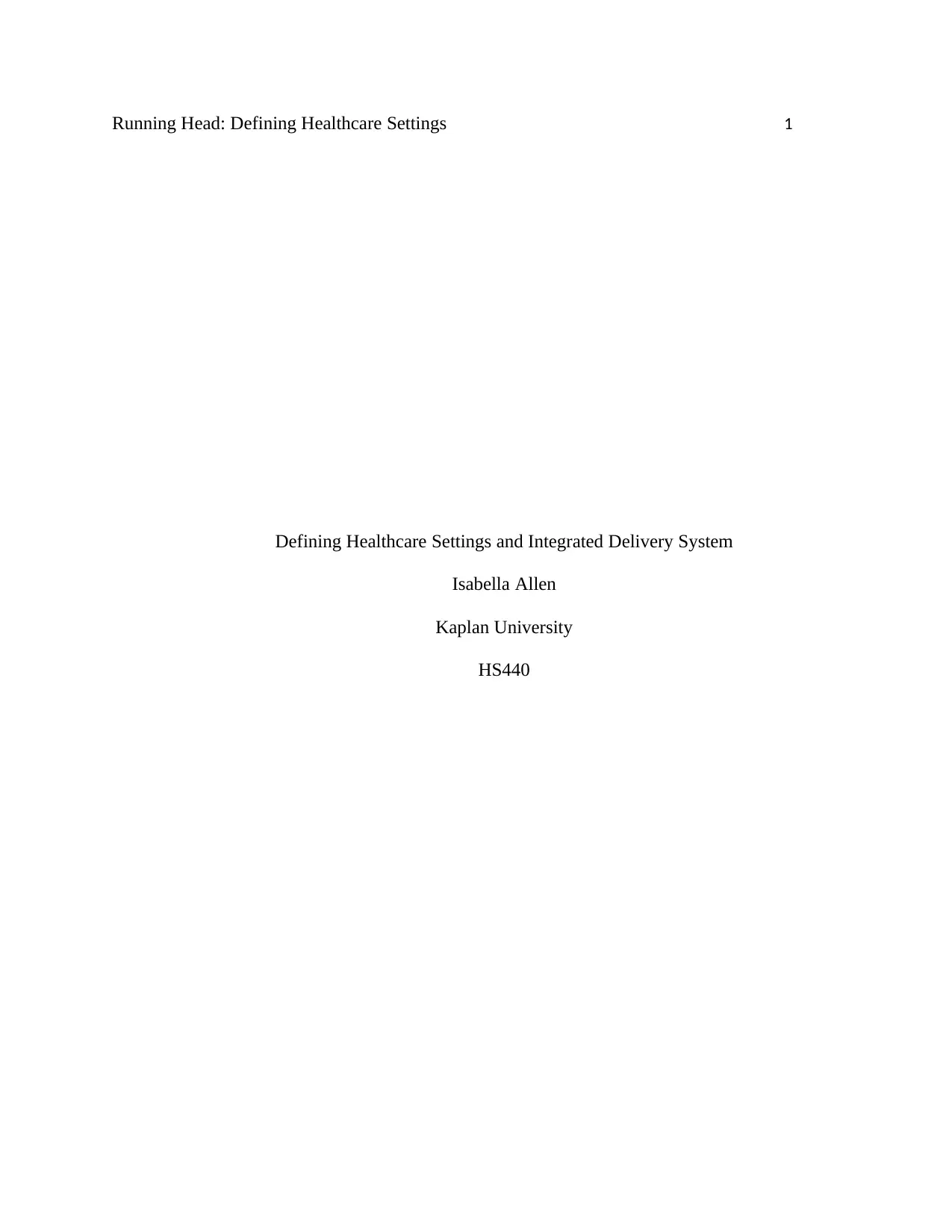
Running Head: Defining Healthcare Settings 1
Defining Healthcare Settings and Integrated Delivery System
Isabella Allen
Kaplan University
HS440
Defining Healthcare Settings and Integrated Delivery System
Isabella Allen
Kaplan University
HS440
Paraphrase This Document
Need a fresh take? Get an instant paraphrase of this document with our AI Paraphraser
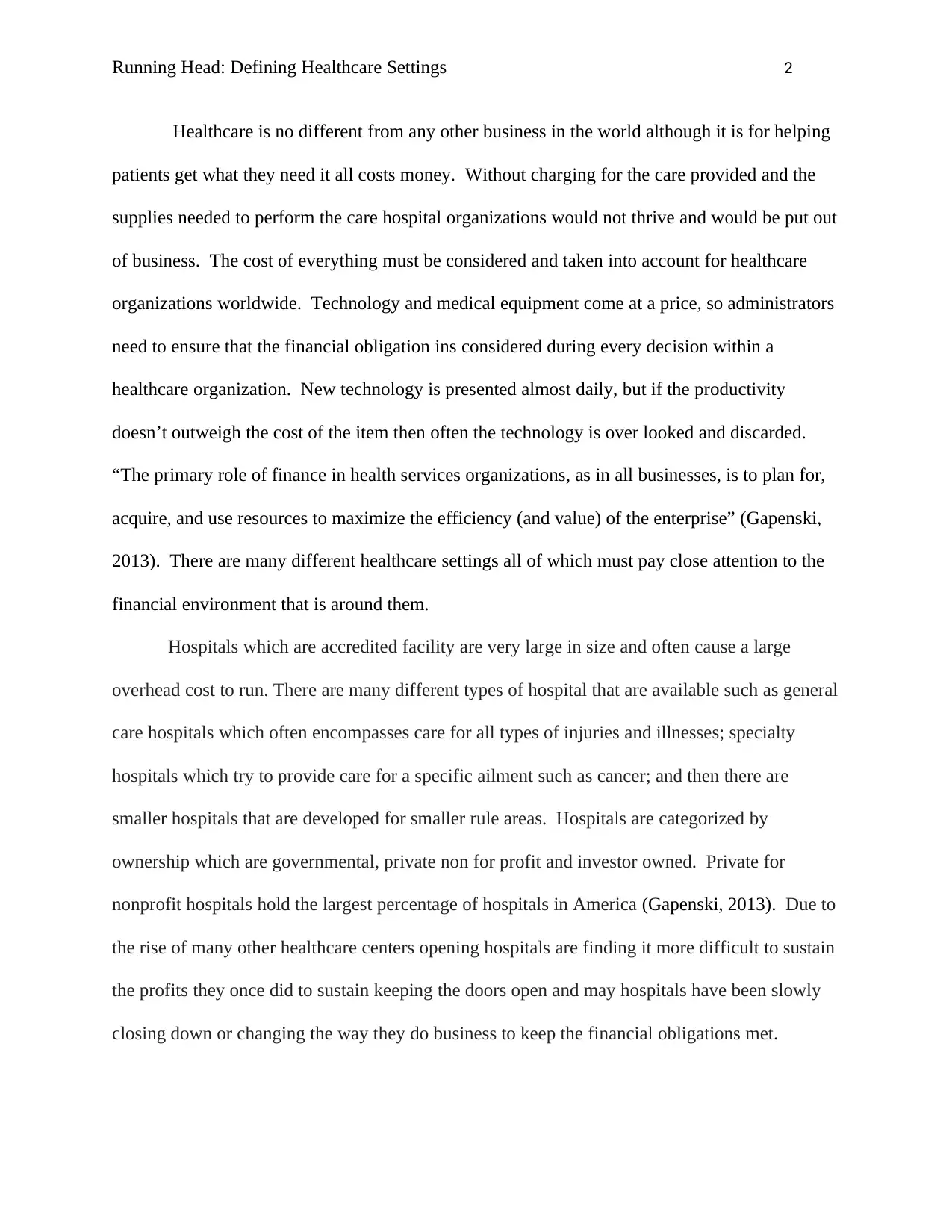
Running Head: Defining Healthcare Settings 2
Healthcare is no different from any other business in the world although it is for helping
patients get what they need it all costs money. Without charging for the care provided and the
supplies needed to perform the care hospital organizations would not thrive and would be put out
of business. The cost of everything must be considered and taken into account for healthcare
organizations worldwide. Technology and medical equipment come at a price, so administrators
need to ensure that the financial obligation ins considered during every decision within a
healthcare organization. New technology is presented almost daily, but if the productivity
doesn’t outweigh the cost of the item then often the technology is over looked and discarded.
“The primary role of finance in health services organizations, as in all businesses, is to plan for,
acquire, and use resources to maximize the efficiency (and value) of the enterprise” (Gapenski,
2013). There are many different healthcare settings all of which must pay close attention to the
financial environment that is around them.
Hospitals which are accredited facility are very large in size and often cause a large
overhead cost to run. There are many different types of hospital that are available such as general
care hospitals which often encompasses care for all types of injuries and illnesses; specialty
hospitals which try to provide care for a specific ailment such as cancer; and then there are
smaller hospitals that are developed for smaller rule areas. Hospitals are categorized by
ownership which are governmental, private non for profit and investor owned. Private for
nonprofit hospitals hold the largest percentage of hospitals in America (Gapenski, 2013). Due to
the rise of many other healthcare centers opening hospitals are finding it more difficult to sustain
the profits they once did to sustain keeping the doors open and may hospitals have been slowly
closing down or changing the way they do business to keep the financial obligations met.
Healthcare is no different from any other business in the world although it is for helping
patients get what they need it all costs money. Without charging for the care provided and the
supplies needed to perform the care hospital organizations would not thrive and would be put out
of business. The cost of everything must be considered and taken into account for healthcare
organizations worldwide. Technology and medical equipment come at a price, so administrators
need to ensure that the financial obligation ins considered during every decision within a
healthcare organization. New technology is presented almost daily, but if the productivity
doesn’t outweigh the cost of the item then often the technology is over looked and discarded.
“The primary role of finance in health services organizations, as in all businesses, is to plan for,
acquire, and use resources to maximize the efficiency (and value) of the enterprise” (Gapenski,
2013). There are many different healthcare settings all of which must pay close attention to the
financial environment that is around them.
Hospitals which are accredited facility are very large in size and often cause a large
overhead cost to run. There are many different types of hospital that are available such as general
care hospitals which often encompasses care for all types of injuries and illnesses; specialty
hospitals which try to provide care for a specific ailment such as cancer; and then there are
smaller hospitals that are developed for smaller rule areas. Hospitals are categorized by
ownership which are governmental, private non for profit and investor owned. Private for
nonprofit hospitals hold the largest percentage of hospitals in America (Gapenski, 2013). Due to
the rise of many other healthcare centers opening hospitals are finding it more difficult to sustain
the profits they once did to sustain keeping the doors open and may hospitals have been slowly
closing down or changing the way they do business to keep the financial obligations met.
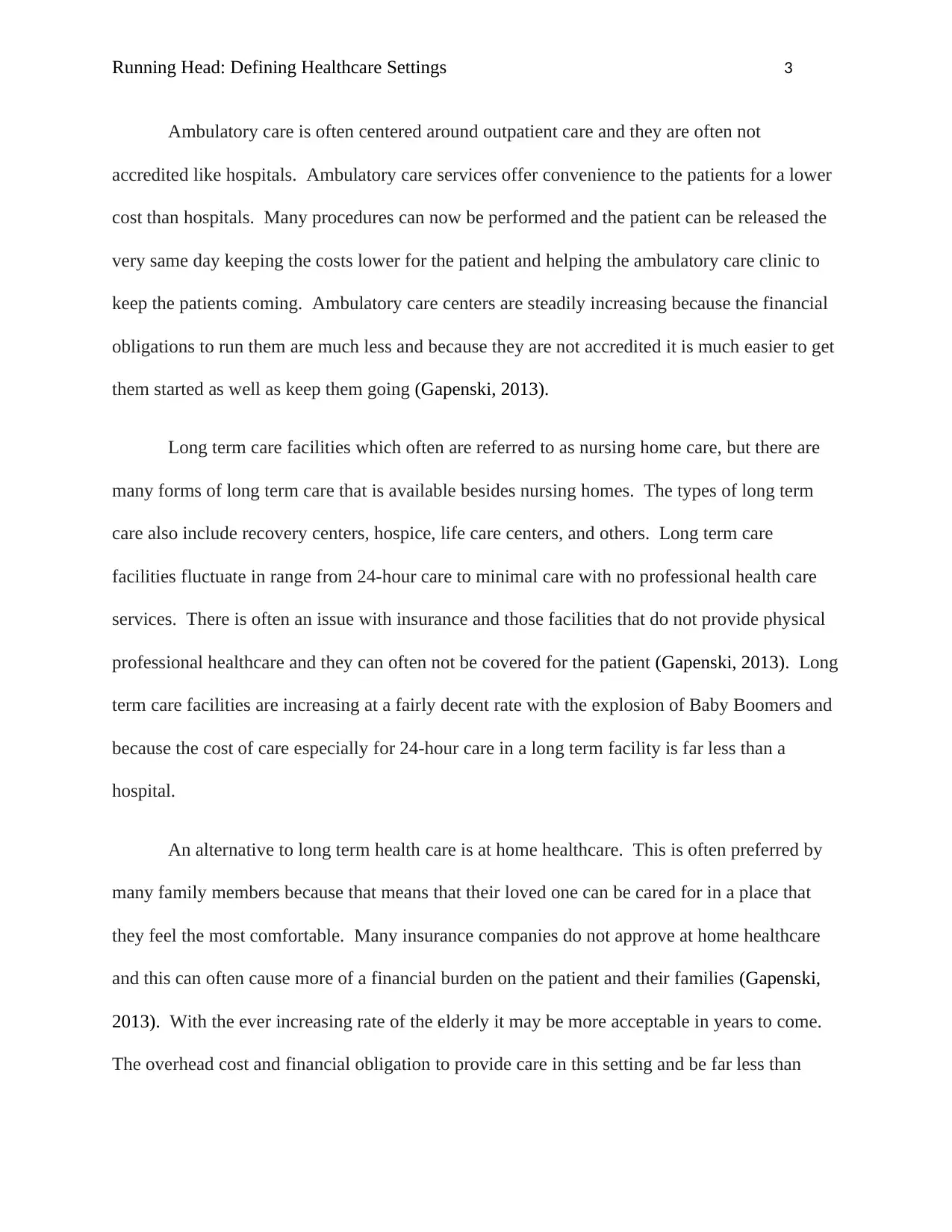
Running Head: Defining Healthcare Settings 3
Ambulatory care is often centered around outpatient care and they are often not
accredited like hospitals. Ambulatory care services offer convenience to the patients for a lower
cost than hospitals. Many procedures can now be performed and the patient can be released the
very same day keeping the costs lower for the patient and helping the ambulatory care clinic to
keep the patients coming. Ambulatory care centers are steadily increasing because the financial
obligations to run them are much less and because they are not accredited it is much easier to get
them started as well as keep them going (Gapenski, 2013).
Long term care facilities which often are referred to as nursing home care, but there are
many forms of long term care that is available besides nursing homes. The types of long term
care also include recovery centers, hospice, life care centers, and others. Long term care
facilities fluctuate in range from 24-hour care to minimal care with no professional health care
services. There is often an issue with insurance and those facilities that do not provide physical
professional healthcare and they can often not be covered for the patient (Gapenski, 2013). Long
term care facilities are increasing at a fairly decent rate with the explosion of Baby Boomers and
because the cost of care especially for 24-hour care in a long term facility is far less than a
hospital.
An alternative to long term health care is at home healthcare. This is often preferred by
many family members because that means that their loved one can be cared for in a place that
they feel the most comfortable. Many insurance companies do not approve at home healthcare
and this can often cause more of a financial burden on the patient and their families (Gapenski,
2013). With the ever increasing rate of the elderly it may be more acceptable in years to come.
The overhead cost and financial obligation to provide care in this setting and be far less than
Ambulatory care is often centered around outpatient care and they are often not
accredited like hospitals. Ambulatory care services offer convenience to the patients for a lower
cost than hospitals. Many procedures can now be performed and the patient can be released the
very same day keeping the costs lower for the patient and helping the ambulatory care clinic to
keep the patients coming. Ambulatory care centers are steadily increasing because the financial
obligations to run them are much less and because they are not accredited it is much easier to get
them started as well as keep them going (Gapenski, 2013).
Long term care facilities which often are referred to as nursing home care, but there are
many forms of long term care that is available besides nursing homes. The types of long term
care also include recovery centers, hospice, life care centers, and others. Long term care
facilities fluctuate in range from 24-hour care to minimal care with no professional health care
services. There is often an issue with insurance and those facilities that do not provide physical
professional healthcare and they can often not be covered for the patient (Gapenski, 2013). Long
term care facilities are increasing at a fairly decent rate with the explosion of Baby Boomers and
because the cost of care especially for 24-hour care in a long term facility is far less than a
hospital.
An alternative to long term health care is at home healthcare. This is often preferred by
many family members because that means that their loved one can be cared for in a place that
they feel the most comfortable. Many insurance companies do not approve at home healthcare
and this can often cause more of a financial burden on the patient and their families (Gapenski,
2013). With the ever increasing rate of the elderly it may be more acceptable in years to come.
The overhead cost and financial obligation to provide care in this setting and be far less than
⊘ This is a preview!⊘
Do you want full access?
Subscribe today to unlock all pages.

Trusted by 1+ million students worldwide
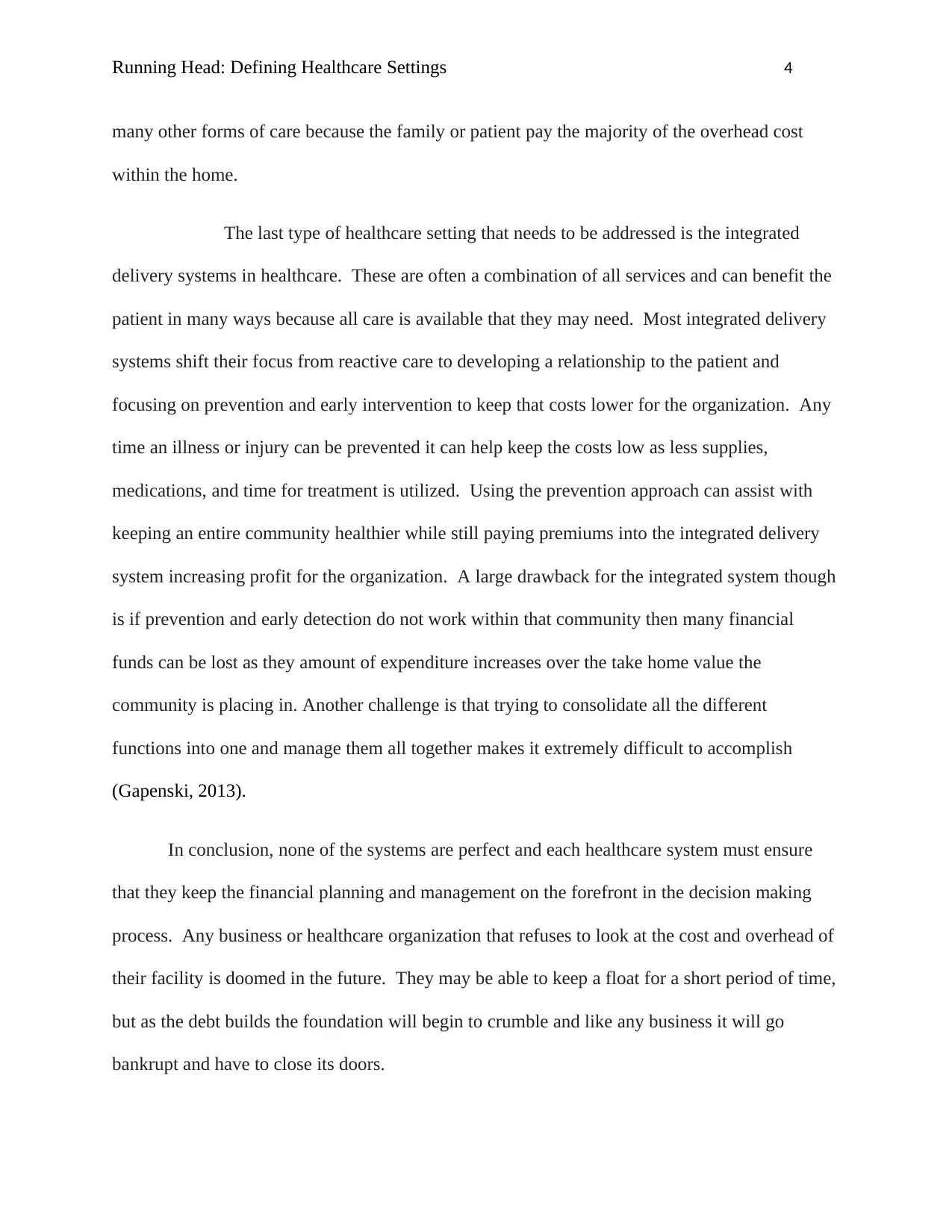
Running Head: Defining Healthcare Settings 4
many other forms of care because the family or patient pay the majority of the overhead cost
within the home.
The last type of healthcare setting that needs to be addressed is the integrated
delivery systems in healthcare. These are often a combination of all services and can benefit the
patient in many ways because all care is available that they may need. Most integrated delivery
systems shift their focus from reactive care to developing a relationship to the patient and
focusing on prevention and early intervention to keep that costs lower for the organization. Any
time an illness or injury can be prevented it can help keep the costs low as less supplies,
medications, and time for treatment is utilized. Using the prevention approach can assist with
keeping an entire community healthier while still paying premiums into the integrated delivery
system increasing profit for the organization. A large drawback for the integrated system though
is if prevention and early detection do not work within that community then many financial
funds can be lost as they amount of expenditure increases over the take home value the
community is placing in. Another challenge is that trying to consolidate all the different
functions into one and manage them all together makes it extremely difficult to accomplish
(Gapenski, 2013).
In conclusion, none of the systems are perfect and each healthcare system must ensure
that they keep the financial planning and management on the forefront in the decision making
process. Any business or healthcare organization that refuses to look at the cost and overhead of
their facility is doomed in the future. They may be able to keep a float for a short period of time,
but as the debt builds the foundation will begin to crumble and like any business it will go
bankrupt and have to close its doors.
many other forms of care because the family or patient pay the majority of the overhead cost
within the home.
The last type of healthcare setting that needs to be addressed is the integrated
delivery systems in healthcare. These are often a combination of all services and can benefit the
patient in many ways because all care is available that they may need. Most integrated delivery
systems shift their focus from reactive care to developing a relationship to the patient and
focusing on prevention and early intervention to keep that costs lower for the organization. Any
time an illness or injury can be prevented it can help keep the costs low as less supplies,
medications, and time for treatment is utilized. Using the prevention approach can assist with
keeping an entire community healthier while still paying premiums into the integrated delivery
system increasing profit for the organization. A large drawback for the integrated system though
is if prevention and early detection do not work within that community then many financial
funds can be lost as they amount of expenditure increases over the take home value the
community is placing in. Another challenge is that trying to consolidate all the different
functions into one and manage them all together makes it extremely difficult to accomplish
(Gapenski, 2013).
In conclusion, none of the systems are perfect and each healthcare system must ensure
that they keep the financial planning and management on the forefront in the decision making
process. Any business or healthcare organization that refuses to look at the cost and overhead of
their facility is doomed in the future. They may be able to keep a float for a short period of time,
but as the debt builds the foundation will begin to crumble and like any business it will go
bankrupt and have to close its doors.
Paraphrase This Document
Need a fresh take? Get an instant paraphrase of this document with our AI Paraphraser
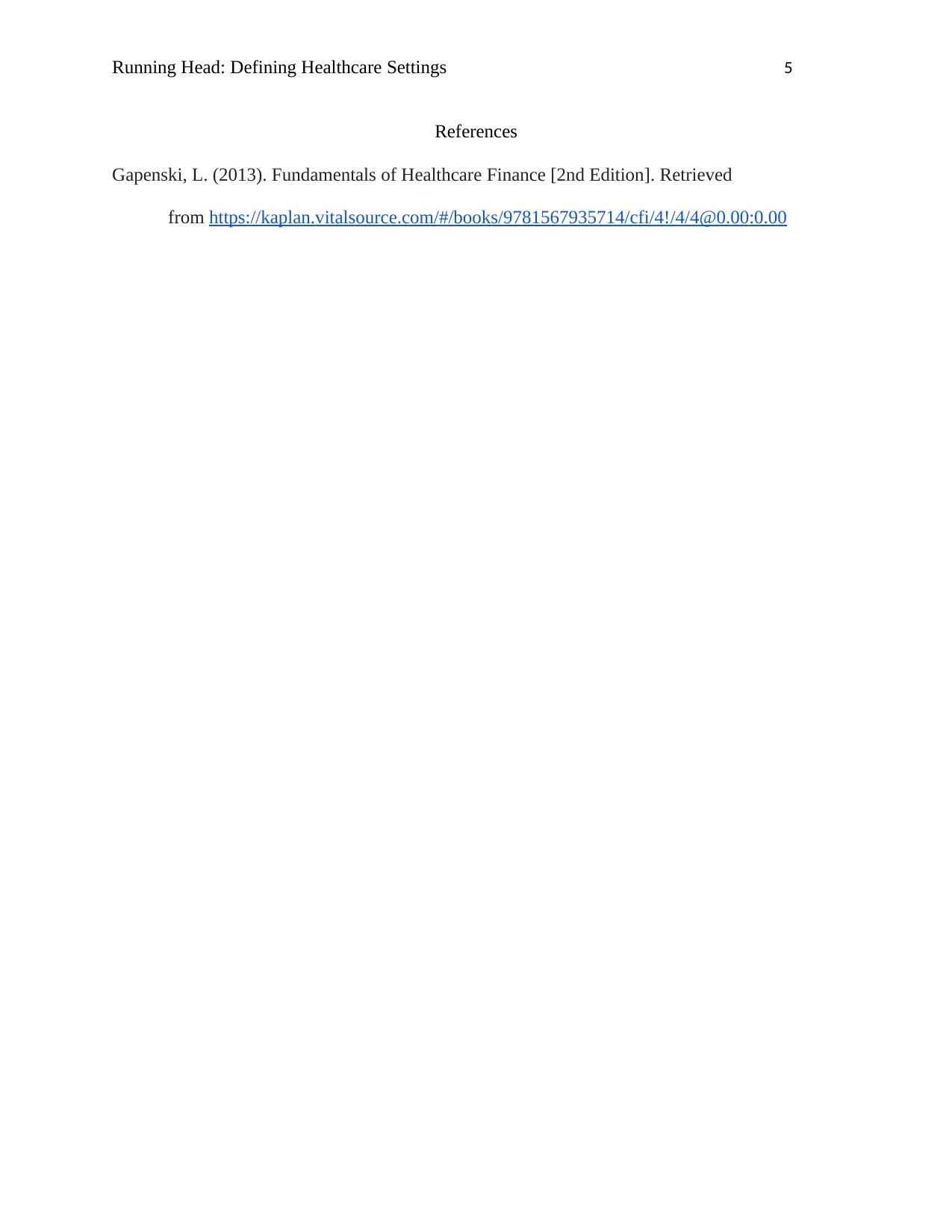
Running Head: Defining Healthcare Settings 5
References
Gapenski, L. (2013). Fundamentals of Healthcare Finance [2nd Edition]. Retrieved
from https://kaplan.vitalsource.com/#/books/9781567935714/cfi/4!/4/4@0.00:0.00
References
Gapenski, L. (2013). Fundamentals of Healthcare Finance [2nd Edition]. Retrieved
from https://kaplan.vitalsource.com/#/books/9781567935714/cfi/4!/4/4@0.00:0.00
1 out of 5
Related Documents
Your All-in-One AI-Powered Toolkit for Academic Success.
+13062052269
info@desklib.com
Available 24*7 on WhatsApp / Email
![[object Object]](/_next/static/media/star-bottom.7253800d.svg)
Unlock your academic potential
Copyright © 2020–2025 A2Z Services. All Rights Reserved. Developed and managed by ZUCOL.





